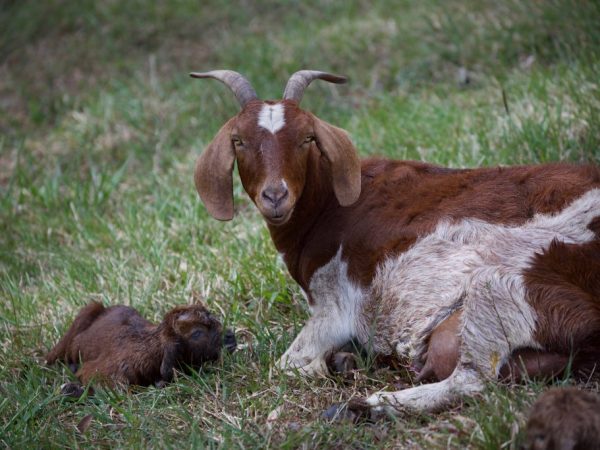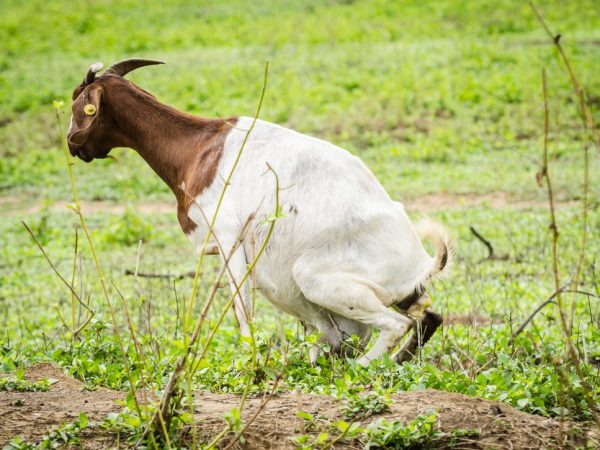What to do if the goat does not leave the afterbirth for a long time
The situation when the goat does not leave the afterbirth is not such a rare occurrence. Usually it leaves the female within three hours, but after another twenty days the body can be cleansed. It is characterized by blood secretions.

Problems with the afterbirth
However, if the retention of the placenta in goats lasts more than six hours, then this is already a violation of the delivery procedure. What to do in this situation? There are several ways to deal with such a nuisance, but usually a veterinarian intervenes.
Why does the goat not leave the afterbirth?
The afterbirth is called amniotic fluid and mucus, sometimes it contains a small amount of blood.
It emerges from the female in about 1-3 hours. The first thing you need to know about the placenta is that in no case should you pull it out yourself. This is especially true for inexperienced farmers. The female can be inflicted with severe pain or even accidentally tear the placenta itself. The parts remaining inside the animal will become a favorable environment for harmful bacteria. Inflammation of the uterus and necrosis can result. Therefore, the first lambing of a goat should be taken by a doctor.
However, what if there is no veterinarian nearby? In this case, you can try to help the goat yourself. First of all, actions should be taken to avoid such a situation. Preparation before lambing is considered to be the launch of a goat and a change in diet. During pregnancy, the amount of milk produced should be reduced, and in the last weeks, artiodactyls are not milked at all. The same applies to the diet - during pregnancy, the goat is fed mainly concentrated feed.
Do not overfeed the animal. Often, being overweight becomes a hindrance to good lambing. If the amount of fat in the body of the goat exceeds the norm, then the uterus will not be capable of strong contractions and contractions. This can cause the retention of the placenta. Other reasons for this pathology can be:
- Malnutrition. This is especially true for dairy goat breeds. If the animal has a low amount of calcium in the body, then problems with the performance of the reproductive system may begin.
- The close relationship of the farmed animals. Due to the relationship between goats, genetic disruptions can occur with the offspring, which can cause the lambing process to go wrong.
- Lack of walking and movement during pregnancy. Very often the health of an animal depends on how much it moves. This usually leads to subinvolution of the uterus. This is the name for the flabbiness of the muscle walls and the inability of the uterus to contract.
- Infections and diseases of a different nature.
- Multiple pregnancy. If there are more than four kids in one litter, then the uterus is very stretched and contains a lot of liquid. It can also slow down the separation of the placenta.
But if you were not present at the lambing and do not know for sure whether the afterbirth came out (after all, it often happens that the goat just ate the afterbirth), it is better to consult a doctor. In such a case, it does not interfere with being reinsured once again.
Medical care for delayed placenta
First of all, the treatment of such a problem should be comprehensive. In addition to affecting the uterus itself, it is imperative to give the pet drugs aimed at supporting the general condition. If the afterbirth has not departed in a day, then the goat may begin a painful shock and the case will end in death.
If the cloven-hoofed animal did not move away during the placenta, then first of all it is necessary to interact with the uterus and increase its contractile capabilities. This will allow the organ to release the content more quickly. If the retention of the afterbirth lasts several hours, then you can help the goat by drinking the amniotic fluid and vaccination. Colostrum is best used as an injection subcutaneously. If this does not help, then such medications are used:
- Oxytotion - one ampoule twice a day intramuscularly. This medication aims to improve uterine contractions. Enter within three days.
- Ditsynon - one ampoule three times a day intramuscularly. This medicine improves blood clotting and vascular health. Applying also for three days.
- Vikasol - one ampoule twice a day. This drug replaces diet, in the absence of the latter. Enter within three days.
- Bitsilin-3 (300,000 EU) is a mild antibiotic used for prophylactic purposes. Reduces the risk of uterine inflammation in case of poor-quality afterbirth, which is an organic medium for many infections. Apply once after lambing, intramuscularly.
These and other drugs should be used until the cloven-hoofed animal is fully recovered. In addition to the afterbirth, it is also necessary to monitor the goat's blood secretions. Retention of afterbirth or poor lambing can cause endothermitis.
At the same time, the discharge becomes purulent with an unpleasant odor. In this case, an X-ray photo should be taken to check the goat's body for tumors. Remember that strong antibiotics can only be prescribed by a specialist doctor and require local change. These drugs put more stress on the liver and kidneys, which have not yet recovered from pregnancy.
Methods for internal cleansing of the goat from the placenta

It's not uncommon for a goat to need help.
As a last resort, you can try to act directly on the placenta itself with the help of certain drugs - ichthioal or Frurazolide. These medications usually look like rectal suppositories and can cleanse or disinfect the animal's body. The fact is that the placenta itself is a good habitat for bacteria and infections. Therefore, in order to protect the goat, such a procedure should be carried out.
A gloved palm is thoroughly lubricated with petroleum jelly or oil, after which it is inserted into the animal's vagina, pushing the medicine. Usually, the reproductive system of goats after lambing is well developed, so the animal will not be harmed. At this moment, the goat should be carefully fixed - due to unpleasant sensations, it may begin to kick or twitch.
It is better for a woman to carry out the procedure - their palms are often smaller and narrower. Do not try this treatment with small breed goats.
In addition to drug treatment. The animal must also receive all types of vitamins and minerals. During delayed afterbirth and postpartum stress, the goat's immunity can be severely weakened. It is best to replenish the necessary complex of vitamins with the help of juicy feed, but if the animal refuses to eat, then you can pierce the nutrients intramuscularly.
The diet of a goat in case of such postpartum complications should consist of:
- root crops;
- pumpkins and zucchini;
- high quality concentrated feed;
- green forage.
If the inflammatory process has not begun and the goat feels tolerable, then during the treatment it is worth organizing small walks for it. Remember that artiodactyls need sunlight for good health.
Sometimes it happens that the afterbirth has already left the female, nevertheless, due to the remains in the vagina, endometritis has developed. Signs of this are unpleasant discharge of a purulent color and cramping movements of the uterus in the animal. In this case, continue to give the same drugs as for the usual delayed placenta. Sometimes a veterinarian can place a catheter in the goat and give an antibiotic to thoroughly clean the uterus. Usually three times are enough for the goat's health to definitely improve.
Some farmers recommend such alternative methods of treating such diseases:
- Nettle infusion is a concentrated decoction of leaves. You can also give the plant in its pure form.
- A decoction of onion peels - for half a liter of water a handful of onion peelings, two tablespoons of sugar and one tea salt.
- Sugar water or glucose solution - 500 grams of sugar are poured into half a liter of boiled water and given to the animal twice a day. This solution will help the animal gain strength after a difficult birth.
Prevention of delayed placenta
To avoid unnecessary complications during childbirth, you should adhere to sanitary standards for keeping goats and a balanced diet. The feed should contain a complex of vitamins and minerals, and also be high in calories. Remember, at the time of pregnancy, the body of a cloven-hoofed animal works in double size. In summer, you should give preference to concentrated feed and fresh herbs rich in vitamins. In winter, instead of greens, you can give the goat succulent feed or silage, which is a good source of energy for the animal. The quality of the feed must meet high standards.
Monitor the external parameters of the animal. Do not overfeed the female and take her for a walk. Remove the barn at least once every three days and ventilate it regularly. Change the bedding the goats are on as often as possible. Do not forget to start - if you drain your goats with frequent milkings, they will not have enough strength to lamb. In this case, the kids may be born healthy, but it will be difficult for the mother to recover from such stress.


